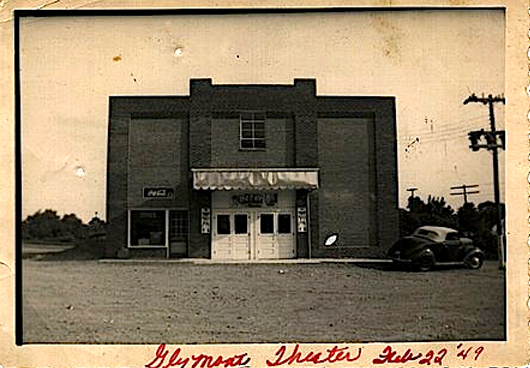The Gly mont Theater opened its doors on February 22, 1949, for a 7:00 P.M. movie. The first night was a special VIP event for the local businessmen and government officials. This was a meet and greet event with hors d’oeuvres and non-alcoholic beverages served to those in attendance. No one remembers the name of the movie or documentary. The Gly mont served the local community for 19 years before the doors were closed for good in September 1968. Southern Maryland Oil Company, out of La Plata, purchased the property in 1968. Arlo Adams continued to manage the Gly mont Theater into late 1968. Demolition began shortly afterward, and construction of a new Texaco Service Station began to take shape. The last movie to play was Jerry Lewis’ “Don’t Raise the Bridge Lower the River.” Attendance was low as it wasn’t a good movie.” It received a 47% rating, and it was 1 hour and 39 minutes long.

Gly mont Theatre
The Raby family built and operated the Gly mont Theater in 1949. On January 21, 1950, a significant fire caused the theatre to be closed for several months. The fire destroyed the $75,000 theater. The owners have released no estimate of damages. The theater had been opened for 13 months when the fire broke out on the stage behind the curtains. The cause of the fire was never determined, but it is theorized that cigarettes could have been the source.
The fire was discovered by Marine Lieutenant Robert K.J. Rossi and Navy Lieutenant Ralph E. Swisher, when they drove by on their way back to the base in Indian Head. They awakened the owners, Jess Raby and his sons, Kenneth and Hubert, who lived within yards of the theater. The Raby’s called the Naval Powder Factory, and other units responded from La Plata, Oxen Hill, Accokeek, Morningside, Clinton, Silver Hill Boulevard Heights, Capitol Heights, District Heights, Colman Manor, Forestville, and Cottage City.
The shivering firemen fought the blaze for over three hours, but in the end, the only thing left standing were the brick and cinder block walls. The much-needed water was pumped from fire hydrants in Potomac Heights. Over 1500 feet of hoses were needed to fight the blazing fire.
Family members worked in the theatre in the early days. Still, I believe every family member (except Wanda, who was too young) was engaged in the work.
The Gly mont Theater, during segregation, had a balcony for those of color. The entrance to the balcony was on the right side facing the building. Very few people that attended the movies had an opportunity to meet Bob and Margaret Hungerford, They ran the concession from February of 1949 until closing in 1968. They were two of the nicest people anyone could have known during a time of ignorance and oppression.
I had the pleasure of visiting their son many years ago. Bobby was 82 years old when me and my brothers, Joe and Bill dropped by and were welcomed into their home. Bobby’s wife Mildred was kind enough to share some of their history and photos of Bobby’s parents. It has been many years since I visited them off of Theater Road (named after the Gly mont Theater) that ran right behind the theater and up the hill. They own the home he was born in and built another home off the same road where they resided years ago.
We thanked them for their hospitality as they shared their knowledge of the history of the area for over two hours. It was a great experience for me and my brothers.
During the era that Val Lyons was the manager, stage shows were held, and drawings were held each week, awarding cash prizes and tickets. One particular stage show featured a trick shot artist who shot cigarettes out of one of the stage show performer’s mouth.
Most of the employees were students from Lackey High School and Archbishop Neale High School in LaPlata. I could probably add other names after some thinking about the fifty’s, but I am sure others can recall and add to this list, especially those listed in this document.
I remember performing many jobs, including riding with my dad as he delivered and posted cardboard signs. It would be neat to find one of those old signs. Leo Isherman, Ronnie Cornett, and Bob Killen also posted cardboard signs. It is fair to say that Bill, Bobby, and Joe Killen changed the billboard signs and worked from an extension ladder. Putting up the poster and changing the marquess was not too bad in the summer, nasty in the winter.
Seating capacity was 499 and 65 to 75 of those seats were in the balcony.





